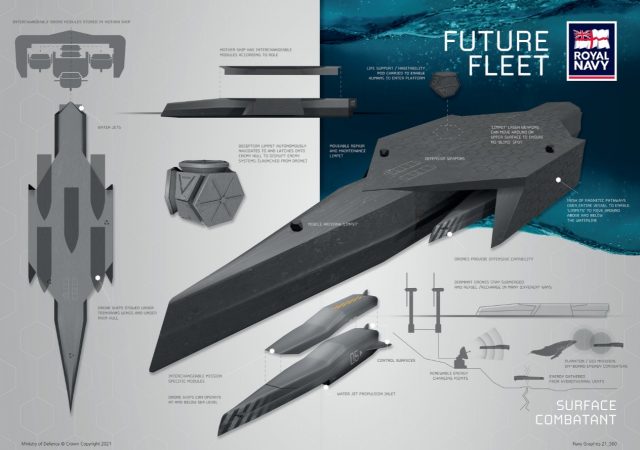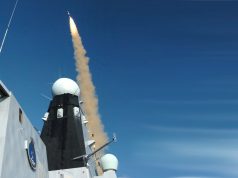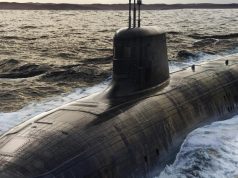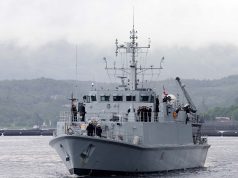
Royal Navy engineers recently sat down to envision how the service could further embrace autonomous technology, including drones.
Led by a design challenge for engineers from UK Naval Engineering Science and Technology (UKNEST), the Royal Navy will develop a “Future Autonomous Fleet” program that could shape the way it operates over the next 50 years.
Stemming from the design challenge, the future vision envisages drones based in the stratosphere to be launched at a moment’s notice; uncrewed fast attack crafts housing smaller autonomous boats; aircraft carriers propelled by both sea-based biofuels and wind power; and an underwater flagship at the center of the fleet.
One of the concepts of the future fleet included an autonomous combatant boat that can work both on the surface and below the waves. Interestingly, the UK defense ministry recently released a request for proposals for a new unmanned surface and subsurface vessel (USSV) for the Royal Marine Commando Force. According to the RFP, the multi-payload, low-signature vessel is to be capable of delivering covert capability both on the surface and sub-surface.

Another concept included a carrier vessel that uses biofuel and wind power to run and houses both uncrewed boats and crewed submarines.
Other conceptual ideas include the increased use of artificial intelligence to assist with low-level planning and underwater transport units carrying anything from munitions to food.
Although in the conceptual phase, the Royal Navy is on track to implement one of these futuristic visions into reality over the coming decade – The Persistent Operational Deployment Systems (PODS).
PODS are interchangeable modules that can be introduced to the surface fleet. Similar in design to a shipping container, the PODS create the idea of a ‘plug and play’ warship and will enable Royal Navy ships of all sizes to be more adaptable and versatile when deployed.
Delivered using technology such as heavy-lift drones or autonomous boats, a ship will be able to receive the equipment it needs to be re-tasked quicker without the need to go into a port to collect it.
Large in size, the PODS will house assets vital to supporting Royal Navy operations. These may include an autonomous boat for surveillance and reconnaissance, quadcopter drones to deliver supplies, humanitarian aid and disaster relief stores or medical equipment. Versatile in their approach, they have the capacity to become an additional medical room for service personnel at sea or a control center for Royal Marines’ operations.
“In a future scenario if we find ourselves unable to compete traditionally in terms of mass, we must think differently if we are to regain operational advantage,” Second Sea Lord, Vice Admiral Nick Hine said.
“The young engineers who worked on this project are thinking radically and with real imagination and reflects how the Royal Navy is thinking too.”
UKNEST young engineer, Fiona McIntosh said: “The collaborative nature of the project, coupled with us being unconstrained in the ideas and technologies we discussed, really helped us base our concept on technologies we thought would be key to innovation over the coming decades.
“The sessions were really interesting and it was great to see all of the concept designs in a presentation to senior Royal Navy officers at the end.
“It was encouraging to see that the designs had some similar features and the groups had envisioned similar technologies being utilized by the future fleet. Hopefully we’ll see some of our ideas incorporated into future platforms.”


























